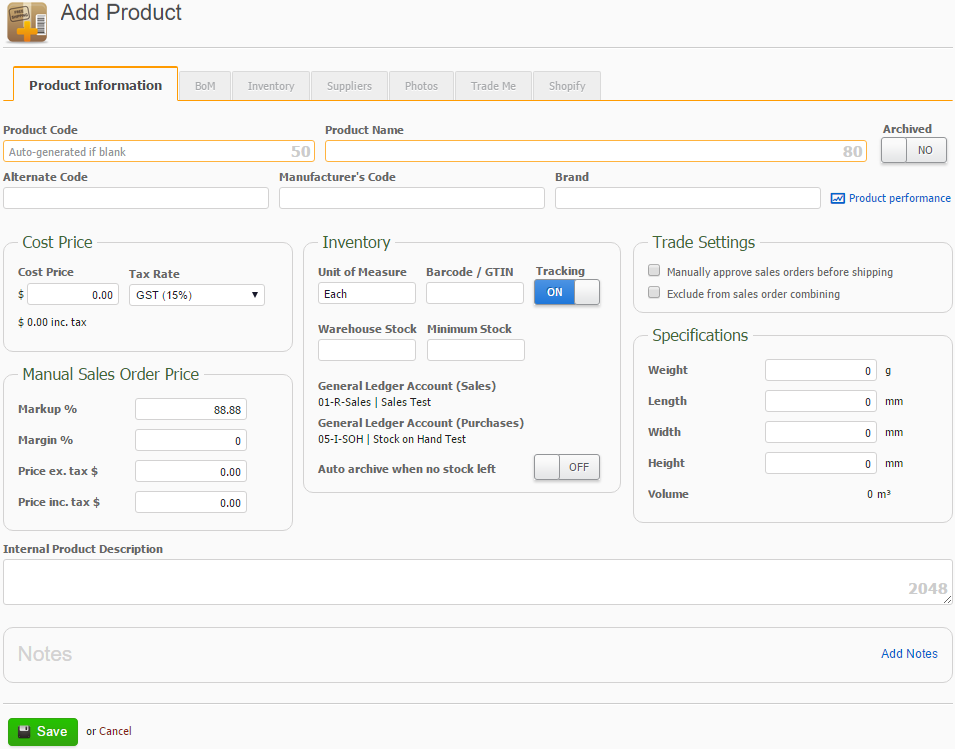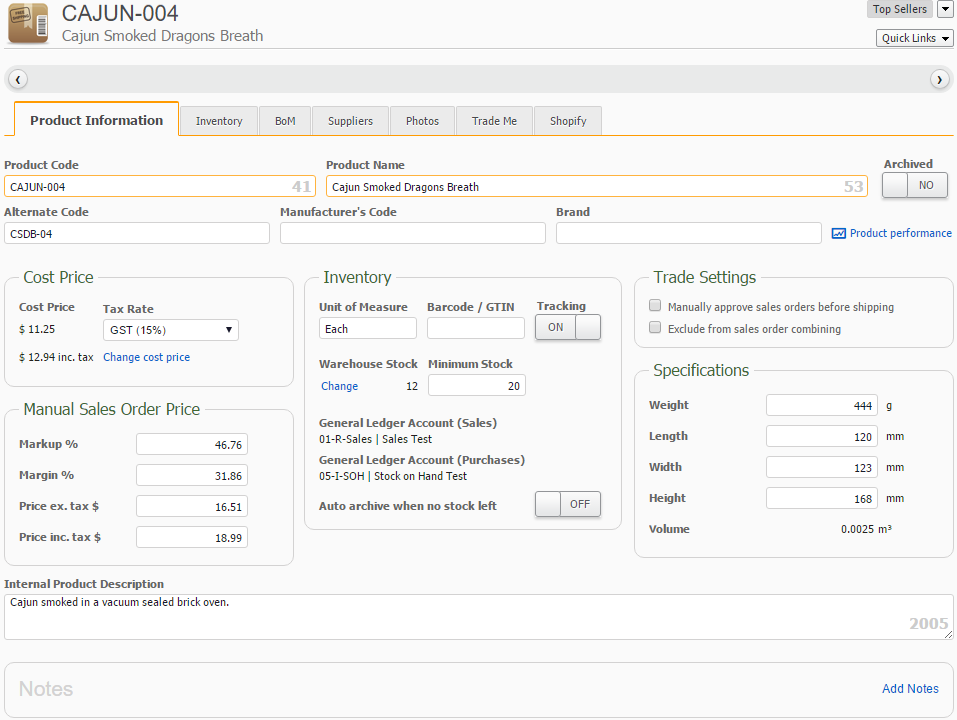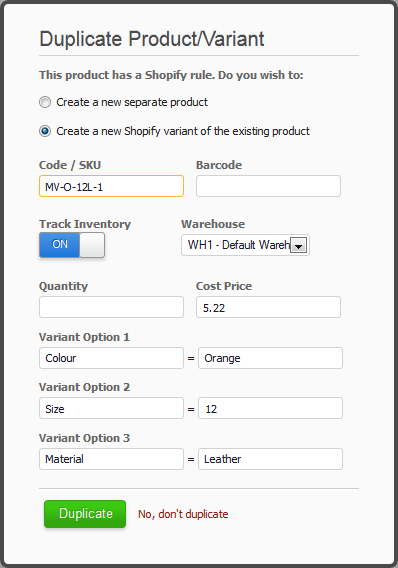- Add a product
- Edit a product
- Copy a product
- Delete a product
- Archive a product
- Edit products in bulk
There are several ways you can add or edit your products. To add a product either select the Add Product link from the Products menu or select the link at the bottom of your list of products or select the Add Product (Simple) menu link. To edit one of your products either click on the product in the main products list or Search by the products code or description.
You can also copy a product to create a new product with similar details. As well as delete unwanted or obsolete products. You can also edit your Trade Me product settings and Shopify product settings for the product via the Trade Me and Shopify tabs.
Adding a product (advanced)
You need to complete the details on the opening Information tab and save, before completing any of the other tabs.

Be very careful with the pricing fields for the first save, as some fields are locked down in some situations. Eg. the Cost Price becomes read only when Inventory Tracking is ON and a Warehouse Stock quantity exists. After this, we will automatically track and adjust the Cost price based on your purchase orders for the product.
Input fields
- Product Code
- Mandatory field. Can be up to 50 characters long. If you leave this blank then we automatically generate a code for you. You can change this code at any time.
- Product Name
- Mandatory field. Can be up to 80 characters long. This should be a succinct name your product.
- Alternate Code
- If you have an alternative product code, then feel free to put a code in here. Can be up to 50 characters long.
- Manufacturer’s Code
- Optional. The manufacturer’s code. Can be up to 70 characters long.
- Brand
- Optional. The brand for your product. Can be up to 70 characters long.
- Archived
- You can archive a product and hide it from view at any time by selecting the Archived button. This is not a full deletion of the product. To retrieve an archived product you will have to filter your product list for archived products and reselect the Archived button.
- If the product exists in Shopify, then it will be removed from Shopify when archiving.
- Cost Price
-
The cost price should exclude GST even if your organisation is not registered for GST.
- Mandatory to a point. If you know the cost price then you should probably provide it. Be aware if you have imported your products from Trade Me, that you will have to supply a cost price, for each product, since Trade Me has no way of knowing the cost price.
- If you have inventory tracking on, then the cost price will not be retained until you have a stock count greater than zero.
- If you have multiple warehouses, then the cost price will be the total average of all warehouses that are not supplier type warehouses.
- Tax Rate
- Select the tax rate to apply to the product.
-
New Zealand organisations should always set the product’s tax rate to GST, regardless of your own tax status. The only exceptions are the zero rated supplies recognised by IRD.
- FIFO cost price
- This is the read only field below the Cost Price. We automatically recalculate the FIFO cost price (first in first out) based on your inventory transactions, if you opted for Inventory Tracking. Purchase orders and stocktakes with new cost prices will affect the calculation. The FIFO cost price is also reflective of the current cost price for the current batch of stock to be used.
- Markup %
- This is the markup between the cost price and the retail sell price excluding taxes (Price ex.tax $). Any time you enter a markup value, the retail sell price excluding tax will recalculate.
- Margin %
- This is the margin for the cost price and the retail sell price excluding taxes (Price ex.tax $). Any time you enter a margin value, the retail sell price excluding tax will recalculate.
- Price ex.tax $
- This is your retail price excluding taxes. Any time you enter either a new markup or a margin, the retail sell price excluding tax will recalculate.
- Price inc.tax $
- This is your retail price including any taxes. Any time you enter either a new markup or a margin, the retail sell price excluding tax will recalculate, which will also recalculate the sell price including taxes.
- Unit of Measure
- This is the standard way that you define a single sale of this product. Eg. each, carton, box.
- Barcode / GTIN
- Optional. This is the product’s barcode or unique GTIN code. You can also scan barcodes directly into the field. Can be up to 100 characters in length.
- Inventory Tracking
- If you want to keep track of your product’s stock levels or you want to subject the product to stocktakes, then you should turn Tracking on. The first time you turn on inventory tracking you should be able to enter a Warehouse Stock quantity.
- Warehouse Stock
- If you opted to track your inventory then this is the physical warehouse stock for the product. Don’t worry, you can do an inventory adjustment at any time from the product’s Inventory tab if you need to remedy the quantity.
- Minimum Stock
- If you like to hold minimum stock quantities or want to be reminded when stock a product drops too low, then set this field. If you are on a plan that features purchasing, and you’ve set up suppliers on your product, then the minimum stock level can be used to auto generate draft purchase orders.
- General Ledger Account (Sales)
- If you are integrated with Xero, then this field needs to be set for your sales. If you have turned off Inventory Tracking then you will need to supply the account mapping for the product, otherwise we will default it from your sales revenue account mapping.
- General Ledger Account (Purchases)
- If you are integrated with Xero, then this field needs to be set for your purchases. If you have turned off Inventory Tracking then you will need to supply the account mapping for the product, otherwise we will default it from your stock on hand inventory account mapping.
- Auto archive when no stock left
- You can prime your products to be automatically archived the next time the product’s stock level hits zero. Auto archiving only applies to product’s with inventory tracking set to on.
- If the product exists in Shopify, then it will be removed from Shopify when the stock drops to zero.
- Manually approve sales orders before shipping
- You can flag the products which require manual approval whenever the product appears on a sales order.
- Exclude from sales order combining
- You can set the products that you want to exclude from sales order combining. When an excluded product appears on a sales order, then the entire sales order will be excluded as a candidate for sales order combining.
- Weight
- The products weight. The display of g (grams) or oz (ounces) is controlled by the Organisation Details setting.
- Length
- The products length or depth. The display of mm (millimeters) or in (inches) is controlled by the Organisation Details setting.
- Width
- The products width. The display of mm (millimeters) or in (inches) is controlled by the Organisation Details setting.
- Height
- The products height. The display of mm (millimeters) or in (inches) is controlled by the Organisation Details setting.
- Volume
- The products volume is automatically calculated providing the length, width and height values have all been supplied.
- Internal Product Description
- Optional. Can be up to 2048 characters long. We have provided a character counter in the bottom right corner of the field to help ensure your product description won’t be too long.
- Notes
- You can create public or private notes. Private notes will only ever be seen by you and your organisation’s authorised users. Public and Private notes can be up to 4000 characters long.
Editing a product
You can edit the details of most of the fields. It would be best to save the changes made on each tab as you go, since some tabs are not the best of friends.
The fields and their inputs are essentially the same as those defined for when adding a product. The Quick Links to other areas should be visible when editing.
When editing a product more of the tabs should be accessible.
The Inventory tab will only be available if inventory Tracking was set to ON. This tab will display a breakdown of all your inventory transactions, as well as allow you to make inventory adjustments. When inventory tracking is on, then a Change link will be available so that you can quickly make stock adjustments to your warehouse stock, if you need to. The Change cost price link lets you quickly change the cost price for the product.
Some buttons are only available when editing your products.
![]()
If you opted to sync your Buy Now prices then the Price including tax will automatically update your Trade Me product price.
- Prints a product label for this product for your DYMO printer.
- Duplicate
- Creates a duplicate product with the same details.
- If you are integrated with Shopify, then you will have the option to simply duplicate the product or duplicate and configure the product as if the product was also a Shopify multi-variant type product.

- Delete
- Deletes the product. If the product has had inventory transactions or sales order exist then the product will be archived instead.
If you want to replace the product codes of your products on a bulk basis, then you will need to import your products (Exporting your current products will give you access to a ready to edit import file. For this the Core Details export file is the better option.). Add a Replacement Code column to your file and use this to specify your new product codes.
You can also navigate to and from the next or previous product record using the left/right buttons above the tabs. This will be based on the sort criteria applied to the Product list before opening the product for editing. If you haven’t resorted the product list, then the default sorting criteria will be used.
![]()
If you have a search filter applied then the search criteria will be highlighted in colour. ![]()
If your product is archived then a banner will be displayed, so you that you are aware the product is archived.
![]()
Copy a product
You can copy existing products to make a new product by viewing a product and selecting the Duplicate button. The new product is automatically created and there is no undo option.
This will copy all the details of the product except inventory. If you are integrated with Trade Me, then auto-listing will be turned off for the product. If you have Shopify web stores, then the product will not be listed in Shopify until you save the Shopify settings. This allows you to fully configure the new product and start listing/selling when you are ready.
New products made from copying will be given a similar code to the copied product, but hyphened with the next incremental number. Eg, if copying ABC13, the new product code will be ABC13-1. If you copy ABC13 again, then the next new product code will be ABC13-2. If you copied ABC13-1, then the new code will ABC13-1-1. You can change the product code at any time.
Deleting a product
You can delete products individually by selecting the Delete button or in bulk via the Products List. Deletions are permanent and cannot be reversed or undone. You cannot delete a product if there are active Trade Me listings, sales orders, purchase orders or if the inventory is not zero. If the inventory tracking is on and the stock level is greater than zero, the product will be archived.
Archive a product
You can archive products individually or in bulk from the Product Information list view. Archived products are not visible in the product list views unless you specifically set the filter to include archived products. To archive a product, open the product and select the Archived button on the Product Information tab.
You can also automatically archive your products the next time they run out of stock. Just set Auto archive when no stock left. This feature only works if you have also configured the product to track your inventory.
Editing products on a bulk basis
You can update several or all of your products by exporting your products, editing the export file and then importing the updated export file(s).
From the Products List select the products or filter the list to refine the results. Then select the Export button to create an export file. Then make your changes to the downloaded export file and import the file. There is no limit to how many times you can re-import.